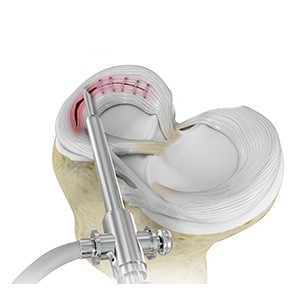- Knee Anatomy
- Knee Conditions
- Knee Procedures
Robotic Assisted Knee Replacement

Robotic-assisted knee replacement surgery is an alternative to the conventional knee replacement procedure. It is performed using robotic-arm technology that allows your surgeon to precisely perform the surgery through a smaller incision as compared to traditional surgery.
Total Knee Replacement

Total knee replacement, also called total knee arthroplasty, is a surgical procedure in which the worn out or damaged surfaces of the knee joint are removed and replaced with an artificial prosthesis. The knee is made up of the femur (thighbone), tibia (shinbone) and patella (kneecap).
Revision Knee Replacement

Revision knee replacement surgery involves replacing a part or all your previous knee prosthesis with a new prosthesis. Although total knee replacement surgery is successful, sometimes the procedure can fail due to various reasons and may require a second revision surgery.
Unicondylar knee Replacement
Unicompartmental knee replacement or unicondylar knee replacement is a minimally invasive surgery in which only the damaged compartment of the knee is replaced with an implant. It is also called a partial knee replacement. Traditionally, total knee replacement was commonly indicated for severe osteoarthritis of the knee.
Knee Fracture Surgery

A knee fracture is a broken bone or a crack in or around the joint of the knee. This can involve the tibia (shin bone), the kneecap (patella), or femur (thighbone) where they connect with the knee. Knee fracture surgery is a surgical procedure performed to correct the cracked or broken bones in or around the knee to restore...
Robotic Unicondylar Knee Replacement
A unicondylar knee replacement is a procedure to replace part of the knee joint with a prosthetic implant to relieve pain and improve the function of the joint. Advances in technology have allowed this procedure to be performed in a minimally invasive manner with robotic assistance.
Knee Arthroscopy

Knee arthroscopy is a common surgical procedure performed using an arthroscope, a viewing instrument, to diagnose or treat a knee problem. It is a relatively safe procedure and you will usually be discharged from the hospital on the same day of surgery.
Minimally Invasive Knee Joint Replacement

Total knee replacement is a very successful surgical treatment for knee arthritis. Over the years, minimally invasive knee replacement surgical techniques have been developed to lessen tissue trauma and improve patient outcomes. This minimally invasive approach involves much smaller incisions than the usual 10-12 inch incisions...
Primary Knee Replacement

Primary knee replacement, also referred to as primary total knee arthroplasty, is a surgical procedure in which the worn out or damaged parts of the knee joint are removed and replaced with artificial knee joints called prostheses or implants.
Complex Total Knee Replacement

Total knee replacement, also called total knee arthroplasty, is a surgical treatment for painful arthritis of the knee in which the worn-out or damaged surfaces of the knee joint are removed and replaced with an artificial prosthesis. Complex total knee replacement is employed in patients whose arthritis is especially severe...
Rapid Recovery Knee Replacement

Rapid recovery knee replacement, also known as an outpatient knee replacement, is an innovative procedure that is performed to replace a damaged knee joint with a prosthesis using minimally invasive techniques and surgical instruments that minimize post-operative pain and discomfort and promote faster recovery for patients.
Complex Primary Knee Replacement

Complex primary knee replacement is a joint replacement surgery performed on a severely damaged or deformed natural knee joint. A thorough evaluation of the unique characteristics of the patient’s knee with the help of advanced diagnostic imaging studies and detailed preoperative planning is performed to ensure positive surgical outcomes.
Partial Medial Knee Replacement

Partial medial knee replacement is a surgery to replace only the medial part of your damaged knee. It is also called unicompartmental knee replacement. The knee is one of the largest and complex joints in your body. The joint is connected to your thigh bones and bones of the lower leg by various ligaments.
Unicompartmental / Partial Knee Replacement

Unicompartmental knee replacement is a minimally invasive surgery in which only the damaged compartment of the knee is replaced with an implant. It is also called a partial knee replacement. Arthritis is the inflammation of a joint that causes pain, swelling (inflammation) and stiffness.
Patellofemoral Knee Replacement

Traditionally, arthritis in only one compartment of the knee is treated by partial knee replacement surgery. Patellofemoral knee replacement is a minimally invasive surgical option performed in the patellofemoral compartment only, preserving the knee parts not damaged by arthritis as well as the stabilizing...
Robotic Assisted Partial Knee Surgery

Robotic-assisted partial knee surgery is an innovative alternative to the conventional surgical procedure to treat degenerative knee diseases such as osteoarthritis. It is performed using robotic-arm technology that allows your surgeon to precisely perform the surgery through small incisions.
Meniscal Surgery

Meniscal surgery is a surgical procedure employed for the treatment of torn or damaged meniscal tissues in the knee. It is mostly performed as a minimally invasive keyhole procedure. Two wedge-shaped cartilage pieces are present between the thighbone and the shinbone. These are called menisci.
Meniscal Repair Surgery

Two wedge-shaped cartilage pieces are present between the thighbone and the shinbone. These are called menisci. They stabilize the knee joint and act as shock absorbers. Meniscus repair is an outpatient surgical procedure to repair torn knee cartilage.
Partial Arthroscopic Meniscectomy

Partial arthroscopic meniscectomy is a procedure to remove the damaged part of a meniscus in the knee joint with the help of an arthroscope. The meniscus is a C-shaped disc of cartilage between your thighbone and shinbone. There are 2 menisci in each knee. They act as shock absorbers and provide stability to the joint.
Knee Surgery

Knee surgery is a surgical procedure for the treatment of a knee injury or condition. The procedure involves repairing diseased or damaged structures of the knee joint in order to eliminate pain and restore normal function. The knee is a complex joint made up of different structures - bones, tendons, ligaments, and muscles.
Patellar Tendon Repair

Patellar tendon repair is the surgery performed to reattach the torn tendon to the kneecap and to restore normal function in the affected leg. Patella tendon rupture is the rupture of the tendon that connects the patella (kneecap) to the top portion of the tibia (shinbone).
Quadriceps Tendon Repair

Quadriceps tendon is a thick tissue located at the top of the kneecap. The quadriceps tendon works together with the quadriceps muscles to allow us to straighten our leg. The quadriceps muscles are the muscles located in front of the thigh.
Knee Trauma Reconstruction

Knee trauma reconstruction is a surgical procedure to repair a soft-tissue injury of the knee such as a torn ligament using a tissue graft or replacing the damaged bony surfaces of the knee joint with an artificial knee joint called a prosthesis.
Knee Osteoarthritis Treatment

Knee osteoarthritis (OA) treatment refers to the various approaches involved in the treatment of the degenerative joint condition called osteoarthritis. The knee joints are lined by soft articular cartilage that cushion the joints and aid in smooth movement of the joint bones.
Partial Knee Resurfacing

Partial knee replacement is an alternative to total knee replacement in patients with arthritis on only one side of the knee. Partial knee replacement is a surgical procedure which involves resurfacing and replacement of only the diseased surface of the joint instead of the entire joint.
Partial Meniscectomy

Two wedge-shaped cartilage pieces are present between the thighbone and the shinbone. These are called menisci. They stabilize the knee joint and act as shock absorbers. Partial meniscectomy is a surgical procedure to remove the torn portion of the meniscus from the knee joint.










